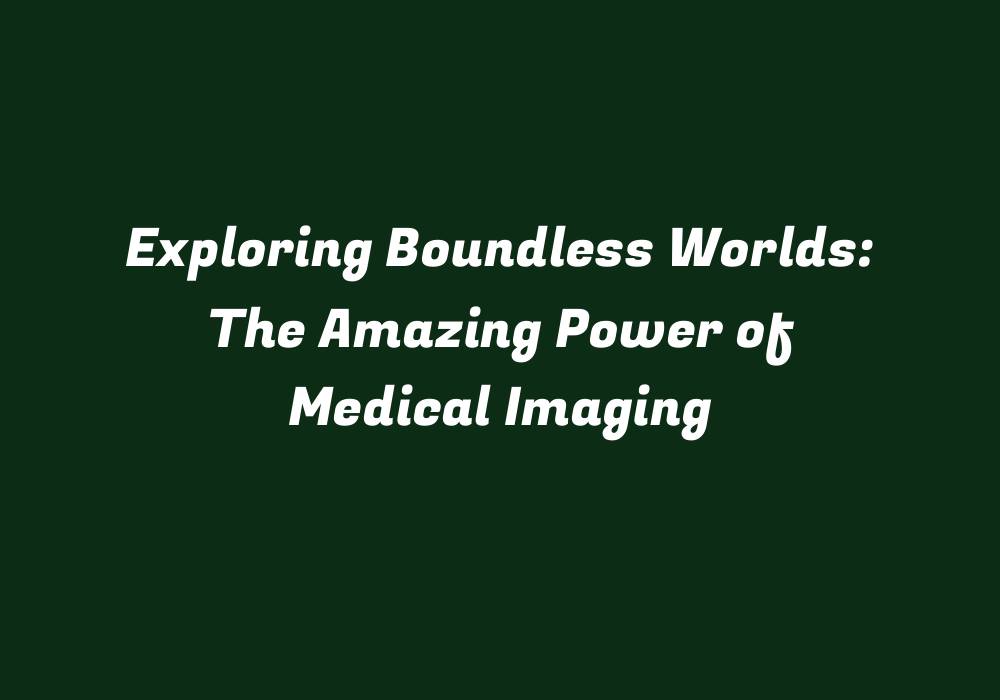Exploring Boundless Worlds: The Amazing Power of Medical Imaging
Introduction
In today’s world, medical imaging has become a critical tool in understanding and treating various illnesses. From diagnosing diseases to monitoring the effects of treatments, these technologies have revolutionized the healthcare industry. This article will delve deeper into how medical imaging techniques are making significant strides in modern medicine, exploring their uses and potential for future advancements.
Computed Tomography (CT) Scans
One of the most common types of medical imaging is a Computed Tomography (CT) scan, which provides detailed cross-sectional images of internal organs and tissues. Using X-rays and advanced computer processing, CT scanners can produce highly accurate images that help doctors diagnose and treat various conditions. For example, they are often used for detecting tumors, assessing bone fractures, or examining the heart for cardiovascular diseases.
Magnetic Resonance Imaging (MRI) Scans
Another popular imaging technique is Magnetic Resonance Imaging (MRI). Instead of using X-rays like CT scans, MRI machines work by exploiting the magnetic properties of protons within human tissues. These protons are sensitive to magnetic fields, and their behavior allows physicians to visualize body structures without exposing patients to potentially harmful radiation. This technique is particularly useful for examining soft tissues, such as muscles, tendons, and joints, as well as the brain and spinal cord.
Positron Emission Tomography (PET) Scans
Positron Emission Tomography (PET) scans are used to assess metabolic processes within a patient’s body by detecting radioactive molecules called tracers that are introduced into the system. These tracers accumulate in specific areas of the body, allowing physicians to visualize and measure tissue function. PET scans are often utilized for diagnosing cancers, neurological disorders like Alzheimer’s disease, and cardiovascular diseases.
Single Photon Emission Computed Tomography (SPECT) Scans
A related imaging technique is Single-Photon Emission Computed Tomography (SPECT), which combines elements of CT scanning with nuclear medicine. SPECT uses radioactive tracers, similar to PET scans, but produces images using a gamma camera instead of a computer. This approach allows for better visualization of blood flow and metabolic activity in the brain, heart, and other organs, making it particularly useful for assessing neurological conditions and cardiovascular diseases.
Ultrasound Imaging
Ultrasound imaging is another crucial medical imaging technique that uses high-frequency sound waves to create real-time images of internal organs and tissues. This non-invasive method can detect pregnancy, monitor fetal development, examine abdominal structures, and assess blood flow in the heart. It is a cost-effective option that does not expose patients to ionizing radiation, making it ideal for use during pregnancy and throughout the early stages of life.
Digital Radiography (DR) and Digital Fluoroscopy
Digital radiography (DR) replaces traditional film-based X-ray techniques with sensors that capture digital images, allowing for improved image quality, faster turnaround times, and increased diagnostic accuracy. DR has become standard in many medical imaging departments and is used for a wide range of applications, including diagnosing bone fractures, assessing dental issues, and monitoring spine conditions. Digital fluoroscopy takes this concept further by providing real-time X-ray images that assist in guiding minimally invasive procedures like endoscopic surgeries or image-guided biopsies.
Future Advances
As medical imaging technology continues to advance, new innovations are set to revolutionize the field even further. These include:
1. Artificial Intelligence (AI): By integrating AI into medical imaging systems, physicians can receive more accurate and efficient diagnosis of complex conditions. This will lead to faster, more precise treatments while reducing the number of unnecessary tests or procedures.
2. Hybrid Imaging Systems: Combining multiple imaging techniques in a single machine can help streamline the diagnostic process by providing comprehensive information from various perspectives.
3. Augmented and Virtual Reality (AR/VR): These technologies will allow healthcare professionals to interact with and analyze medical images more effectively, potentially improving surgical planning and patient outcomes.
4. Personalized Medicine: With advancements in genomic analysis and precision medicine, doctors will be able to tailor treatments based on a patient’s unique genetic profile, further enhancing the effectiveness of medical imaging techniques.
In conclusion, medical imaging has already played an integral role in transforming modern healthcare by providing valuable information for diagnosis, treatment planning, and monitoring of various diseases. As these technologies continue to evolve, they will undoubtedly have a profound impact on the future of medicine and the overall well-being of patients worldwide.
